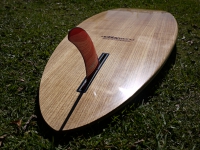第二次世界大戦後、
アメリカ軍が横須賀や佐世保等に進駐し、
鎌倉、唐津等でサーフィンをした事により、
近代サーフィン文化が日本に広まりました。
しかし、それよりずっと以前に
海の恵みと共に生活していた日本には、
独自の浪乗り文化が存在していました。
After World WarⅡ(post 1945),
the American occupation army came
to Japan and soldiers surfed fiberglass
longboards at Kamakura,Karatsu and
beaches around the military bases.
But before that, Japan had a traditional
culture of surfing over 100 years old.
Like the Polynesians, Japanese people
subsisted off the bounties of the sea
where they, too, discovered how to ride
waves in the ocean.
Article chapter-1
Text by Nobby
江戸時代中期(1700~)頃、木材加工技術の発達により板材の流通が増え、
一般の漁民達の為に、それまでの丸太船から木造の和船が多く作られ始めました。
From mid-Edo Period(1700~), Japanese style wooden boats were crafted
thanks to the development of timber processing technology
Previously most fisherman used canoes made by hollowing out and shaping logs.
その和船の船底に敷く揚げ板の事を板子(イタゴ)と云い、
漁師が漁を終え、和船を浜に上げた後、板子(イタゴ)を使い
波乗りをしたのが板子(イタコ・イタゴ)乗りの始まりと推測されています。
地方により呼ばれ方は様々で、板ッ子{大磯}、瀬つかし{新島}、
瀬のし{山形}、せぶた{徳島}等と呼ばれていました。
勿論そのままイタゴと呼ぶ地方もありました。
Most Japanese-style wooden boats had removable floor boards
that were called 'Itago'. When the boats were beached after fishing,
children took the 'Itago' and surfed with them.
This surfing style was commonly known as 'Itago-nori'
which means 'Floor board riding'.
It is also called "Itakko"at Oiso Kanagawa
"Setsukashi" at Niijima island of the Izu island chain
"Senoshi"at Yamagata North eastern Japan
and"Sebuta"at Tokushima Shikoku
These names, such as 'Itako' or 'Itago', come from different regions of Japan.
今の所、いつ、どこが板子乗りの起源なのか、まだ判っていません。
文政4年(1821), 俳人'独樂庵寛理 'が「山形県鶴岡市湯野浜で瀬のしがされていた。」
と日記に記し、それが日本最古の文献とされています。
Itago's origins are still uncertain.
The oldest written document is a diary of "Dokurakuann Kanri" one haiku poet who lived in Sakata.
He visited Yunohama beach, north eastern Japan in 1821
and saw children riding on the waves with 'Itago'
しかし、その後板子はハワイの様に、王様がサーフィンをする程に
一般的に発展する事はありませんでした。
その理由は、漁師達の仕事場である海で遊ぶ事は、
恵みをもたらす神聖な場所を冒涜し汚すと考え、
良く思われていなかったからと考えています。
But it was not as popular as in Hawaii where everyone,
including kings and queens, enjoyed surfing.
That’s because in Japan the sea was the place fisherman worked.
It was not considered a place for recreation or amusement.
明治時代、(1880年代)愛知県大野海岸千鳥ヶ浜を筆頭に
各地で海水浴場がオープンしました。
最初は医療目的とされていましたが、すぐにレジャー用に開放されました。
海に入る事が良しとされていなかった民衆が、公に海で遊び始めました。
In the 1880's, bathing beaches were opened for medical purposes.
however this changed as public beaches soon came to be used for pleasure.
Then, common people came to beaches for leisure.
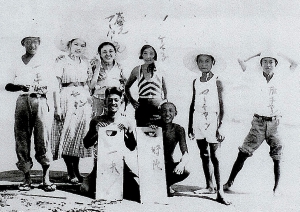
鵠沼 / 1935年
資料提供:鵠沼郷土資料展示室
Kugenuma / 1935
collection: Kugenuma Local Museum
この頃から、船の揚げ板だった’板子(イタゴ)’は
波乗りの道具として広く作られ始めました。
From this period, the 'Itago' wave riding tool began to be widely made.
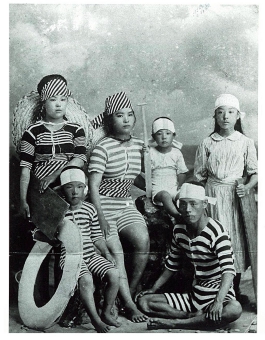
飯田善雄氏所蔵
Courtesy / Yoshio Iida
板子に関する最古の記述 / 1821年(文政4年)
The oldest document / 1821
酒田の俳人"独樂庵寛理"が1821年湯野浜湯治に来て付けた日記である
This is the note that Dokurakuan Kanri, a "haiku" poet,
wrote in his diary from 1821,
while living in Sakata, Yamagata Prefecture where he could take hot-spring baths for medical purposes at nearby Yunohama Beach.
It was there where he came upon children joyfully playing "senoshi", a local word meaning wave riding, by using the "itago" (wooden floor boards).
「この辺の12,3歳位の子供達が10人ばかり、
手に手に舟の板を持って、荒波の中へ飛び込んで沖へ沖へと乗り出していく。
沖へ出たかと思うと今度は波に乗り岸に向かって戻ってくる。
その早いこと、矢のようである、これを何回もくりかえしている。」
Perhaps ten children of 12 or 13 are there,
taking the boat's planks they go,
embarking and diving into the racing sea,
further and further out they go,
then riding the waves they come back to shore,
fast, like an arrow, so many times they go.
「日本體育叢書 第十二編 水泳」
「Library of Japan Physical Education 12 Swim」
1924 (大正13年)
佐藤三郎 著
Author : Saburo Sato
Copied from the original by Susumu Tsuji
「(前略)濤乗りの練習には先づ板子を以て練習するがよい。
It's good practice to use 'Itago' to improve your body surfing
(中略)
練習の初めには足先の着き得る浅瀬で試みるがよい。
At first, it would be better to practice in the shallow water
where you can stand
濤頂を待って濤が小さいときは濤頂が三尺位
大きい時は一間程も後に來た時、底を蹴って跳び出し
Wait in the shallow water and when a swell comes behind about 90cm
or when bigger swell comes behind 180cm,
you must push off the bottom with your toes and
take off on the wave.
(第百三十三圖)
體をなるべく平たく、短距離のクロールの姿勢になり、
板子を持つたときは片手で支へて足はバタ足を細かく使ひ
片手で片抜手を速く細かく使つて乗る。
When you are taking off,
make your body preferably flat like a sprint crawler.
Then, grab the 'Itago' with one hand to hold up your body
and do flutter kicks with a short stroke
and with the other hand you must do a short, fast overarm swing stroke.
一旦乗つたら手は兩手とも板子にかけ、足はバタ足を使つて
少しづつ濤から残されるのを防ぎながらいけば岸邊まで乗つて行ける。
Once you are surfing on the wave, grab the 'Itago' with both hands
and continue flutter kicks to prevent missing out on the wave.
Then you can ride for the inside.
(第百三十四圖)(後略)」
Copied from the original by Susumu Tsuji
「板子を使用する場合は主として次の三の場合である。
1、溺るるものを救ふとき又は遠泳などで
非常に疲れた者を救ふときに持つて行くとき。
2、難船等の場合一身を救ふため。
3、始めて泳を學ぶとき。
You can use 'Itago' for the following purposes.
1. To save a drowning person or exhausted swimmer.
2. To save yourself from shipwreck etc.
3. When beginning to learn to swim.
(中略)縦に板を用ふる法
百廿六圖のやうに板を縦に用ひて泳ぐのであるが。
The method of paddling is to use the 'Itago' lengthwise
as in the above illustration.
板は腰骨に當て體は板に乗りかゝるやうにし
先手の肱から曲げて腕を斜に板の上に置き指は他方の縁を握り、
足を扇り受け手を片抜手一段の要領で掻いて進む。
Place the tail of the 'Itago' on the hip bone and hold up your body
with one hand on the 'itako' and diagonal with the elbow bent and grab that side rail.
Do flutter kicks and with the other hand do an overarm swing stroke.
此時板の先端は水面から四五寸出して
水面を辷るやうな気持で泳ぐがよい。(後略) 」
When paddling, keep the nose up about 12-15cm
with a feeling like gliding on the water's surface
目黒書店
Article chapter-2
Text by Nobby
1890年代以降、板子は様々な用途に進化していきました。
The 'Itago' evolved for various purposes after the 1890's
海水浴場が出来た事によって、板子は一般客の水泳補助具として使われ
夏の海遊びの一つとして広く認知されました。
神奈川県大磯の海水浴場(1885~)には板子が貸出用に用意され、
スポンサーの名前が書かれた物もありました。
The 'Itago' was widely used as a tool to assist with swimming
and known as one of the pleasures on the beach in summer.
At Oiso, 'Itago' were painted with the name of the beach house
that rented the 'Itago' or the name of the company who donated 'Itago'
for use by the common people.
水泳補助具としての板子はその後に水泳練習用のビート板として進化していきました。
The 'Itago' was widely used a tool to assist with swimming
and was also used for bodyboarding, one of the pleasures on the beach in summer.
After that, It evolved into a kickboard for swimming practice.
Circa 1937
出典:「新日本読本」 齋藤巍洋著
(上写真)1936年ベルリンオリンピック5位の根上博選手
また、本来舟の揚げ板だった板子(イタゴ)は
漁師たちにとっては緊急時の救命具でもありました。
自分達の命を守る為にパドルや板子乗りの技術を磨いていた事は
後に板子をレスキューボードとして進化させ、
海水浴場やプールに配備されました。
明治時代後期には長さが6尺から7尺(180~210cm位)、
幅一尺三寸(39.5cm位)の長い板子も現れました。
And the 'Itago' ship floor board was used as a fisherman's lifesaving equipment.
The fishermen and their children practiced the 'Itago' riding and paddling.
It evolved into a rescue board and was used to prevent accidents
at the bathing beaches and pools.
It was 180~210cm length and about 40cm width.
そして勿論、波に乗る道具として板子は発展しました。
And of course, the 'Itago' evolved as a wave riding tool for the wave rider.


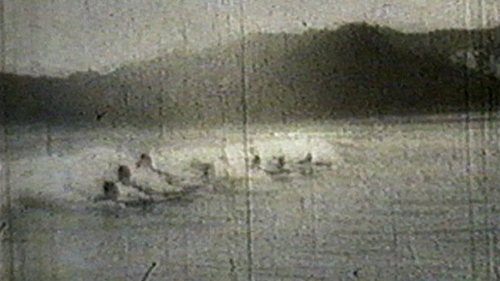
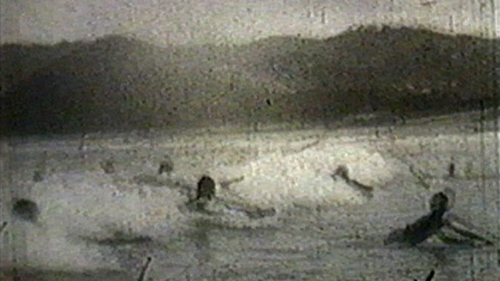
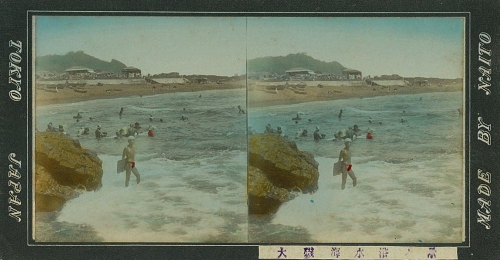
 contact > Nobby
contact > Nobby

